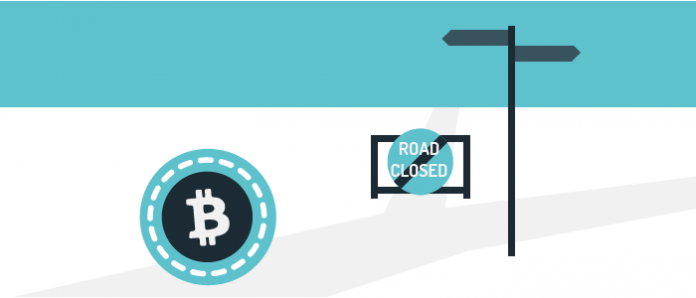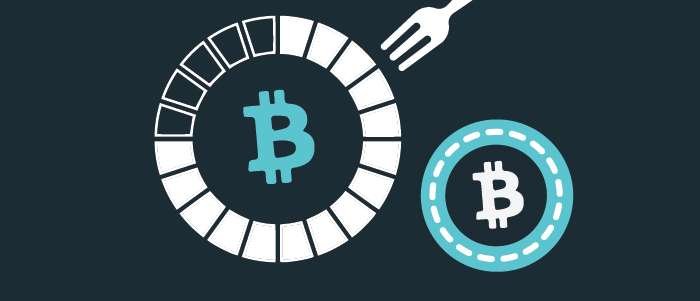
It turns out that the scary Bitcoin hard fork that could have potentially split the chain won’t happen after all.
Bitcoin blockchain was supposed to split into two blockchains in roughly few days, but the developers behind SegWit couldn’t reach consensus in the bitcoin community.
Although it has always been a controversial plan, now that Bitcoin SegWitx2 fork has been cancelled, it leaves everyone with a question – what’s next for Bitcoin?
The currency has been on a steady rise since August 2017, reaching over $7,000 just a few days before the fork plans turned into ashes.
Many invested in Bitcoin, hoping to receive free coins after the potential chain split, hence the enormous growth in value. However, within two days of announcing that SegWit2x wouldn’t happen, Bitcoin lost over $1,000 in value.
So what will happen next for Bitcoin?
What Is SegWit?
In a nutshell, the SegWit2x fork should have increased the transaction block to 2 megabytes.
Bitcoin has been struggling with scalability issues for a long time. The discussions about a potential improvement have been circulating for about two years, but only earlier in 2017, a group of developers have settled for SegWit in a so-called New York Agreement.
From the beginning, the plan wasn’t the most welcomed solution by the majority of Bitcoin network, hence the Bitcoin turmoil over the last few months.
The historical Bitcoin upgrade was divided into two stages:
Stage 1 – SegWit
With SegWit, the transaction data is stored differently in each block. This results in an improved transaction capacity of the Bitcoin blockchain. At the same time, this upgrade is compatible with older versions of bitcoin software.
Another additional feature is the Lightning Network – a solution to Bitcoin’s scalability issues.
Instead of running every transaction through the blockchain, transactions between two addresses could happen on a sidechain. It eases off the load from the main blockchain, and the sidechain can be settled now and then.
The first SegWit stage occurred in August 2017. The main Bitcoin blockchain has been upgraded with SegWit, while those who didn’t agree, forked off and created an altcoin – Bitcoin Cash.
The upgrade went smoothly and surprisingly; it didn’t cause too many distractions for the main Bitcoin network.
Stage 2 – SegWit2x
The second stage was planned to be introduced in November 2017. It would increase the transaction block size from 1MB to 2MB.
Since the transaction processing time increased from 10 mins to few hours, SegWit2x would allow for a quick confirmation and Bitcoin could compete on the market yet again.
While the first stage was a soft fork, the second phase would have been a hard fork. Meaning, everyone would have to upgrade the system to SegWit2x, or accessing the Bitcoin network wouldn’t be possible anymore.
Why Did Developers Cancel SegWit2x?
The fork was so much of a controversial plan that it could have split the community into two separate branches and coins.
The plan was disputed not only because it lacks consensus, but also due to the design choices made by the development team behind one of the software clients associated with the New York Agreement.
SegWit2x have also questioned Bitcoin decentralised nature. Since it was a group of individuals making a decision and only seeking confirmation from the rest of the network, Bitcoin could potentially risk its decentralised nature.
To keep the community together, SegWit2x backers have decided to cancel the fork. The announcement has been signed by developers who agreed on SegWit2x earlier on this year in New York:
- Mike Belshe – BitGo
- Wences Casares – Xapo
- Jihan Wu – Bitmain
- Jeff Garzik – Bloq
- Peter Smith – Blockchain
- Erik Voorhees – Shapeshift
As the developers’ note says:
“Although we strongly believe in the need for a larger blocksize, there is something we believe is even more important: keeping the community together. Unfortunately, it is clear that we have not built sufficient consensus for a clean blocksize upgrade at this time. Continuing on the current path could divide the community and be a setback to Bitcoin’s growth.”
What’s Next for The Bitcoin Network?

Almost everything that has been happening around Bitcoin for the last few months was associated with the upcoming November hard fork.
The price has significantly increased, the volatility has been gradually declining, and some were predicting Bitcoin to reach a $10,000 price mark.
Is this still possible?
It’s natural, the price automatically dropped as soon as the SegWit2x news has been announced, but it doesn’t mean that Bitcoin won’t keep on going up.
Here are the next three steps of the Bitcoin network:
Step 1 – Bitcoin First Sidechain Is Introduced
As mentioned before, a sidechain is a separate blockchain from the main Bitcoin blockchain, but it still allows the use of Bitcoin token (BTC).
Funds can be moved between those two blockchains, but when they become frozen on the main blockchain, they would automatically become activated on the sidechain.
Sidechains are a well-known solution for trying new features that are too experimental for the main blockchain. It’s an excellent way of testing new features, but without compromising the security and already established elements on the main blockchain.
There are already plans for RSK sidechain to be introduced by the end of this year. Initially, it will be managed by some of the well-known Bitcoin companies, but in the future, the platform will become more decentralised, with miners having more control.
Since a sidechain is not exactly the safest solution, for those who opt for it, there is an incentive of a lower transaction fee. But at the cost of reduced security and increased centralisation.
Step 2 – Lightning Network
The Lightning Network has been seen as a perfect solution to Bitcoin scalability issues for a long time.
It’s a system of smart contracts that allows users to perform transactions in a low-trust (eventually trustless) manner, but off the main Bitcoin blockchain.
The transactions receipts are sent between users off the main chain, while the blockchain is used to resolve any potential conflicts and disputes.
The low-trust solution results in the block space being limited by the number of users, rather than some transactions.
The alpha version of the application that uses Lightning Network is already available, but it’s unclear when the fully-available version will be available.
Step 3 – Potential Block Size Hard Fork Will Be Discussed
The plans to increase Bitcoin’s scalability definitely won’t be forgotten. Another proposal will likely be introduced in 2018, but there is a possibility it will be made of all of the three already existing upgrades – SegWit, Lightning Network and sidechains.
However, the next proposal will hopefully look at a permanent solution, such as increasing the block size gradually, instead of a sudden bump in size.
Even though Bitcoin SegWit2x fork was cancelled, it doesn’t mean it’s over for Bitcoin. We should be expecting more proposals and solutions to come, but the price will likely keep on growing.
And, if you’re wondering what’s next for Bitcoin, you have to wait. Because, as the SegWit2x situation showed – putting together a proposal, and gaining consensus for the hard fork, don’t necessarily go together.



![Bitcoin Buyer Review of Official Website [2022] bitcoin buyer review featured image](https://bitemycoin.com/wp-content/uploads/2022/04/bitcoin-buyer-review-featured-218x150.jpg)
![Bitcoin Digital | Official Website Review [2022] bitcoin digital review featured](https://bitemycoin.com/wp-content/uploads/2022/04/bitcoin-digital-featured-218x150.jpg)



